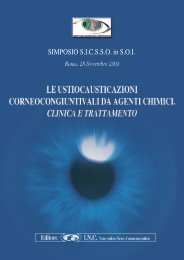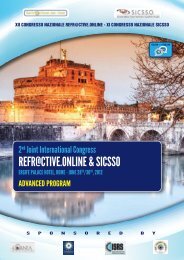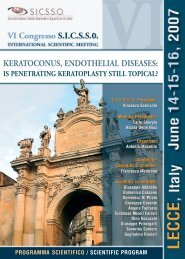1st EuCornea Congress
1st EuCornea Congress
1st EuCornea Congress
You also want an ePaper? Increase the reach of your titles
YUMPU automatically turns print PDFs into web optimized ePapers that Google loves.
<strong>1st</strong> <strong>EuCornea</strong> <strong>Congress</strong> venice, 17-19 june 2010<br />
FREE PAPER Abstracts<br />
Batisti, Cinzia<br />
The translationally controlled tumour protein (TPT1,<br />
also known as TCTP) is present in human cornea<br />
C. Batisti 1 , L. Buratto 2 , G. Tosi 1 , P. Eposti 1 , F. Menicacci 1 , E. Motolese 1 ,<br />
P. Arcuri 3 , S. Tripodi 3<br />
1. Department of Opthalmology Siena, Italy<br />
2. Hospital Dell’angelo, Mestre-Venezia, Italy<br />
3. Department of Human Pathology and Oncology, Siena, Italy<br />
Purpose: We have investigated for the first time about the presence of<br />
TCTP in normal human cornea.<br />
Setting and Methods: We have analyzed by immunohistochemistry<br />
and immunoblotting human corneal samples obtained by penetrating<br />
keratoplasty.<br />
Results: In the normal human cornea TCTP was evidenced by<br />
immunohistochemistry in the basal and intermediate layers of corneal<br />
epithelium. This antigen showed a cytoplasmatic distribution.Furthermore<br />
the presence of TCTP have been confirmed by immunoblotting.<br />
Conclusion: These results documented for the first time that TCTP is<br />
present in human cornea.<br />
Financial Disclosure: 0<br />
Bellucci, Roberto<br />
Optical quality of eyes after lamellar corneal surgery<br />
R. Bellucci, C. Chierego<br />
1. Ophthalmic Unit, Hospital and University of Verona, Italy<br />
Purpose: To study the optical quality of eyes operated on with lamellar<br />
corneal surgery in order to identify the influenting factors.<br />
Setting: Ophthalmic Unit, Hospital and University of Verona, Italy<br />
Methods: Eyes operated with deep lamellar keratoplasty (DLK, 21 eyes),<br />
endothelial keratoplasty (DSAEK, 22 eyes) and penetrating keratoplasty<br />
(PK, 9 eyes) have been studied 6 months or more after surgery. Visual<br />
acuity and contrast sensitivity, corneal topography and thickness, and light<br />
scattering have been measured and compared.<br />
Results: Visual acuity and contrast sensitivity were poorly related.<br />
Contrast sensitivity and light scattering were related with corneal thickness,<br />
and especially with corneal bed thickness in DLK. Anatomical disruption<br />
of corneal lamellae was also a cause of poor results. Eyes with PK<br />
always had better quality than eyes with lamellar surgery. In 7 eyes with<br />
lamellar surgery the OQAS system was simply unable to obtain reliable<br />
measurements.<br />
Conclusion: Lamellar surgery offers worse optical quality than<br />
penetrating keratoplasty. Increased patient satisfaction only came from the<br />
reduced postoperative time to visual recovery and from the reduced corneal<br />
astigmatism in this study.<br />
FINANCIAL DISCLOSURE: 0<br />
Bersudsky, Valery<br />
Management of endothelial decompensation due to<br />
glaucoma shunt tube touch by descemet’s membrane<br />
endothelial keratoplasty and tube revision<br />
V. Bersudsky, A. Treviño, S. Rumelt<br />
Western Galilee- Naharyia Medical Centre, Israel<br />
Purpose: To describe trimming of a glaucoma shunt tube with<br />
Descemet’s membrane endothelial keratoplasty (DMEK) for treatment of<br />
endothelial decompensation caused by tube-endothelium touch.<br />
Setting: Tertiary referral center<br />
Methods: An 84-year-old male with pseudoexfoliative glaucoma OU<br />
had endothelial decompensation due to touch of the tube of an Ahmed’s<br />
glaucoma valve at the corneal endothelium OS. The best-corrected visual<br />
acuity (BCVA) decreased from 20/60 to counting fingers at 3 feet. The<br />
patient underwent uncomplicated trimming of the shunt tube and DMEK.<br />
Results: Following surgery, the cornea became clear and BCVA improved<br />
to 20/60. The intraocular pressure remained normal (8-12mmHg) without<br />
anti-glaucoma medications and endothelial cell count remained stable in a<br />
follow-up of 12 months. No complications were encountered.<br />
Conclusions: Glaucoma shunt tube trimming with DMEK may<br />
be considered in cases of endothelial decompensation due to tubeendothelium<br />
touch and may replace penetrating keratoplasty for<br />
such cases.<br />
FINANCIAL DISCLOSURE: 0<br />
Bonini, Stefano<br />
OCULAR ALLERGIES<br />
S. Bonini<br />
Dept Ophthalmology University of Rome Campus Bio-Medico, Rome, Italy<br />
Ocular allergies represent one of the most common conditions affecting the<br />
ocular surface. The term of ocular allergy includes distinct clinical conditions<br />
such as Seasonal or Perennial allergic conjunctivitis (SAC and PAC,<br />
respectively), Vernal Keratoconjunctivitis (VKC), Atopic Keratoconjunctivitis<br />
(AKC) and giant papillary conjunctivitis (GPC). These conditions share<br />
several anamnestic, diagnostic and clinical features. History of allergy,<br />
high levels of specific serum IgEs and positive skin test to allergens are a<br />
common finding in SAC and PAC, and are described in approximately 50%<br />
of patients with VKC. Atopic dermatitis is constantly present in patients with<br />
AKC. While SAC and PAC generally represent a mild to moderate disease,<br />
in AKC and VKC inflammation frequently involves the cornea, resulting<br />
in more severe symptoms and possibly permanent visual damage. VKC<br />
typically presents with a cobblestone-like appearance of the upper tarsal or<br />
limbal conjunctiva, associated with mucus discharge, corneal damage and<br />
intense itching. More severe forms of VKC are easily distinguishable from<br />
other allergic conjunctivitis, while the mildest forms do not always show<br />
these typical manifestations. Current treatments for ocular allergy include<br />
use mast cell stabilizers, histamine receptor antagonists, corticosteroids<br />
and immunomodulators. New topical agents with dual antiallergic activity<br />
(mast cell stabilizers and antihistamine) may be used for long-term<br />
treatment of allergic inflammation, to alleviate signs and symptoms of<br />
mild forms of ocular allergy. Symptoms and signs of severe forms are not<br />
adequately controlled unless prolonged steroid-based therapies are used.<br />
However, steroids should be used with particular caution due to their ocular<br />
side effects including glaucoma and cataract. Recently, topical treatment<br />
with cyclosporine A eye-drops has been proposed for more severe forms<br />
of AKC and VKC. The efficacy of topical cyclosporine A in these conditions<br />
requires further investigations with long-term randomized clinical studies.<br />
Buzzonetti, Luca<br />
The big bubble technique in deep anterior lamellar<br />
keratoplasty assisted by IntraLase femtosecond laser.<br />
One year follow up<br />
L. Buzzonetti 1 A. Laborante 2 G. Petrocelli 1<br />
1. Ophthalmology Department, Bambino Gesù Children’s Hospital, Rome, Italy<br />
2. Ophthalmology Department, Casa Sollievo Della Sofferenza Hospital,<br />
San Giovanni Rotondo, Italy<br />
Purpose: To report one year follow up after deep anterior lamellar<br />
keratoplasty (DALK) assisted by IntraLase femtosecond laser performed<br />
with the big-bubble technique.<br />
Setting: Ophthalmology Department IRCCS’Casa Sollievo della<br />
Sofferenza’ Hospital, San Giovanni Rotondo, Italy Methods: 15 eyes with<br />
keratoconus were treated using a 60 kHz IntraLase (AMO) that performed<br />
a lamellar cut 100microns above the thinnest corneal point (Oculus<br />
Pentacam). From the same depth, the IntraLase created a mushroom<br />
shaped lamella. The donor thickness was differently calculated in each<br />
patient according to an original model. Removed the recipient lamella,<br />
air was injected into the residual stroma to achieve a big bubble. The<br />
keratectomy was continued up to Descemet’s membrane. The donor was<br />
fitted into place and sutured using interrupted suture, removed by the 8th<br />
postoperative month.<br />
Results : A big bubble was successfully achieved in 13 eyes. One, 3, 6<br />
and 12 months after surgery mean BSCVA (0.25±2.1, 0.35±1, 0.41±1.8,<br />
0.52±1.2), spherical equivalent (-1.2±2.9, -0.5±3.4, -1.9±3.1, -2.5 2.7<br />
diopters), (by Oculus Pentacam) refractive and topographic astigmatism<br />
(-1 2.3, 0.3 5.5, -1.2 3.0, -2.0 2.6, and 6.5±2.7, 4.4±1.7, 3.9±1.5, 2.9±1.6<br />
41







